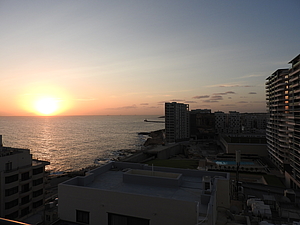Malta 2020
Holiday in Malta – 20th – 30th September 2020
GEOGRAPHY
Malta is an archipelago consisting of 7 tiny islets with total area 316 km2. Its population is estimated at around half a million. The former settlement was known as Maleth meaning “safe haven”, and the whole island began to be referred to by that name. Malta is one of the most isolated places in the Mediterranean. It is situated between Sicily and the North African Coast, the distance to the south of Sicily is three and a half hours by ship. Malta does not have a direct connection by sea to Tunisia in the west, it is necessary to travel via Sicily and get on a ship in one of the Sicilian harbors. The whole journey to the Tunisian capital would take 17 hours. It is interesting that although Malta has an outstanding architecture and amazing nature, you will not find here one single forest. None of the islands has any mountains or rivers either. 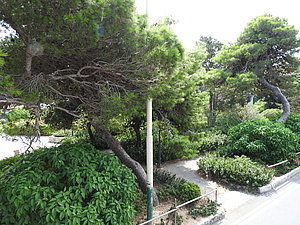
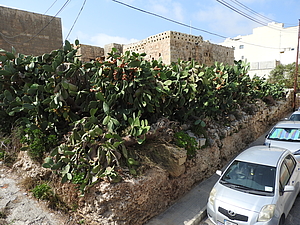
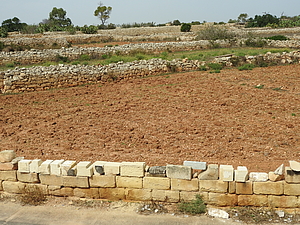
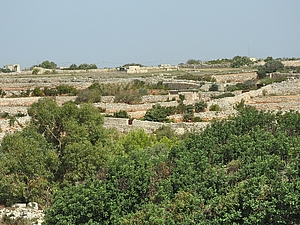
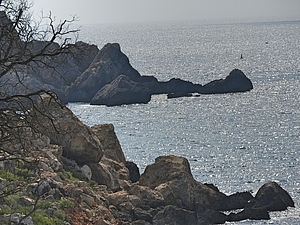
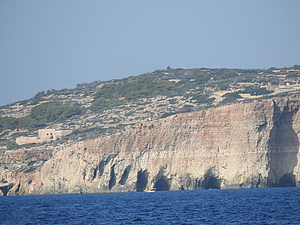
HISTORY
Despite the geographic isolation, there is an evidence that civilization has existed in Malta since the early Neolithic period of 5000 BC. The Maltese Islands went through a golden Neolithic period, the remains of which include eleven so called Megalithic Monuments of Malta, mysterious temples dedicated to the goddess of fertility which are UNESCO World Heritage Site listed.
The Maltese Islands fell under the hegemony of Carthage around the middle of 6th century BC, along with most other Phoenician colonies in the western Mediterranean. The Phoenicians, the Carthaginians, the Romansand the Byzantines, all left their traces on the islands.
In 60 A.D. St. Paul was shipwrecked on the island while on his way to Rome and brought Christianity to Malta.
The Arabs conquered the islands in 870 A.D. and left an important mark on the language of the Maltese (Maltese/Malti is the only Semitic language which uses Latin alphabet). Until 1530 Malta was an extension of Sicily: the Normans, the Aragonese, the Hohenstaufen and other conquerors who ruled over Sicily also governed the Maltese Islands.
Charles V, Habsburg Emperor, King of Spain and Emperor of the Holy Roman Empire, bequeathed Malta to The Knights Hospitallers of the Order of St. John of Jerusalem which then ruled over Malta from 1530 to 1798. This Order, commonly known as the Order of Malta or the Knights of Malta, is a Catholic lay religious order, traditionally of military, chivalric and noble nature. It has been also called "the smallest sovereign state in the world".
The Great Siege of Malta took place in 1565 when the Ottoman Empire attempted to invade the island of Malta, then held by the Knights Hospitaller. The Knights of Malta, with approximately 2,000 foot soldiers and 400 Maltese men, women, and children, led by Grand Master Fra' Jean de Vallette (Valletta, the capital of Malta, was named after him) withstood the siege and repelled the invaders. This victory became one of the most celebrated events of sixteenth-century Europe, it undoubtedly contributed to the erosion of the European perception of Ottoman invincibility, although the Mediterranean continued to be contested between Christian coalitions and the Turks for many years.
Following the Great Siege of 1565, the Knights took Malta through a new golden age, making it a key player in the cultural scene of 17th and 18th century Europe. The artistic and cultural lives of the Maltese Islands were injected with the presence of artists such as Caravaggio, Mattia Preti and Favray who were commissioned by the Knights to decorate churches, palaces and auberges.
The Reformation which split Western Europe into Protestant and Catholic states heavily affected the Knights as well. In several countries, including England, Scotland and Sweden, the Order was dissolved. Some parts of the Order adhered to Protestantism in German and Anglo-Saxon countries. When this adherence was not given, the properties of the Order were confiscated by Protestant Princes and the Order suppressed. In England, the King confiscated all its properties and named himself Grand Master. This fake order became a royal honorific order that exists to this day.
In others, including the Netherlands and Germany, entire bailiwicks or commanderies (administrative divisions of the order) experienced religious conversions; these "Johanniter orders" have survived in Germany, the Netherlands, Sweden and many other countries, including the U.S. and South Africa until today. It was established that the Order should remain neutral in any war between Christian nations.
In 1798 Napoleon, on his way to Egypt, stopped his fleet of 600 ships in Malta. In the morning of 10th June he conquered the Island of Gozo and part of the Isle of Malta, under strong cannon fire. In the evening negotiations for an armistice were established. The Grand Master Ferdinand von Hompesch completely capitulated on 12th June, negotiated with Napoleon to receive a good settlement for himself and left for Trieste; 300 French knights were taken prisoners and sent to the Antibes; many
knights of other nationalities were sent to England and Italy.
Napoleon abolished the Order of Malta and confiscated its treasures, ships, artillery and properties. His army started to plunder the churches, which made the religiously minded Maltese population his enemies. It was one of the reasons why the French presence on the islands was short lived. The Island was governed by the French military until a rebellion of the people supported by the English navy drove the French away in 1800.
However, the Order of the Knights of Malta never regained the island of Malta. After Napoleon expelled them, the Knights of Malta scattered across Europe, and for a few decades they became invisible. They reunited only in the middle of the 19th century. Today, the Order of the Knights of Malta is based in Rome and has its envoy in Malta. The first envoy was Count Kinský of Bohemia in the late 1990s, he became also Grand Prior of Czech Maltese Knights between 2002 - 2004. One of the six Grand Priories of the Order in the whole world has its seat in Prague. The highest representative of the Order has a title of the prince and grand master. He is elected for life by the state council, received the rank of prince of the Holy Roman Empire in 1607 and has been superior to the ecclesiastical cardinal since 1630. The Order of the Knights of Malta rejects to have anything common neither with the Freemasons, nor with the schismatic Russian branch, which has not been recognized by the Pope, nor with the German branch of the Maltese Order, which was eradicated after the Protestant revolt and restored by the Prussian Frederick Wilhelm IV in 1852 under the name "Evangelical Johannites". This royal order of St. John is in charge of hospital assistance but has nothing to do with the original Order of Malta, although it uses the same symbols.
The rule of Great Britain over Malta was confirmed by the European powers by the Treaty of Paris in 1814. The Maltese adopted the British system of public administration, education and legislation.
Malta became independent only in 1964 as a part of the Commonwealth with a British queen as a head of the state. Modern Malta became a republic in 1974. It started to carry out independent neutral foreign policy, the foreign military bases on the island closed down permanently in 1979, its neutrality was anchored in the constitution in 1987. Malta joined the European Union in May 2004, the Eurozone in January 2008. It also belongs to the signatories of Schengen Agreement. At the moment it is a Labour party which is in power.
Impressions from Malta
· a well organized country
· no crowds, probably also due to Corona, because normally there is still high season in September in Malta
· busy construction activity, a large number of cranes, certainly a few hundred, maybe even thousands, visible on the horizon, at each corner there is some scaffolding, concreting, new facades being made. I don't think there would be such a construction boom in any other European city
· bad roads in some northern parts of the country, but new ones on the southern ring, obviously Malta tries to improve its infrastructure – we passed through several tunnels. The bus network is very good.
· beautiful old villas - but the gardens are very rare, the soil is arid, space insufficient
· as many years ago in England, there are no garbage bins, garbage is thrown in front of the house in plastic bags or boxes, people dispose of anything in front of their houses, the population does not seem to recycle at all, maybe that is being done somewhere centrally. Fortunately, garbage collectors are passing around and collecting everything very often, otherwise it would be unbearable especially due to the high temperatures
· local cuisine: I tasted the main local specialties: stewed rabbit in wine, rabbit goulash (stuffat tal-fenek), bragioli (beef olives) - the dish has nothing to do with olives, it is more like Czech “Spanish birds”, i. e. beef roulade, just with a little different filling (it tastes well), spiced bigilla, a spread made from black or brown beans, which they often serve with crackers (I did not like it). Besides the very tasteful rabbit, they prepare excellent fish and fruits de mer of all kind.
· due to its untouched nature, calm coastline, ancient artifacts and relative abandonment, Malta has been used as a backdrop for the filming of many Hollywood productions, from "Gladiator" and "Troy" to "Captain Philips" to the TV series Game of Thrones.
Diary
20th September
Dortmund - Frankfurt Airport by train (speed of the train up to 300 km, arrived exactly). Lufthansa's central check-in was closed, instead a huge Corona testing centre had opened there. We have got our boarding passes already printed via Internet, which is under normal circumstances no great advantage, because the suitcases have to be physically handed over at the airline counter anyway. But this time everything was a self-service. There was an automatic machine for reading boarding pass codes, and after the machine read the codes again, it printed a paper tape with a code of suitcases destination which we had to fasten on the suitcases ourselves as well. This absolutely automated procedure without assistance of any employee also meant that we didn't have to pull out our passports or ID cards at all. The only hassle was security check, as usual. How pleasant it would be to travel around Schengen Europe by plane if it were not for security checks, as it was the case some years ago! The flight from Frankfurt to Malta took two and half hours.
A hotel taxi was already waiting for us – a lady taxi driver was talkative and explained among others about the Corona situation in Malta. Originally, they used to have a minimum number of cases, sometimes seven days in a row without any case at all. At the moment, however, they had around a hundred new cases a day. The government has tightened the rules and there are huge fines for non-compliance. She also complained about the economic situation: to buy her own apartment is beyond her means, all real estate in Malta is very expensive so that an ordinary employee even can´t get a mortgage which would be sufficient. Her yearly salary was around 17 000 Euro. Later on we realized that this is really not much, as prices in Malta are high, approximately on the same level as in England. The journey to our hotel took less than half an hour.
Our hotel
Our hotel was situated in a town of Sliema and had an unusual name - “1926”. We found out that this was the year of birth of the owner and founder of the hotel. We received in advance by email a number of our room and a code which would let us in (one of the measurements to avoid queuing at the reception, no keys nor cards). Upon arrival, we found out, that our room on the 8th floor had a view directly at the building site. The house was nearing completion, but still, it was a building site. The room was also quite small. When we complained, the receptionist showed us two other rooms, which did not have a view at the construction site, but were even worse for various other reasons. Then he showed us a room that was significantly better, but the hotel wanted additional payment twice the price we paid so far. George said we were willing to pay an extra 200 euros, but that was not enough. So we didn't move. However, George, who had selected this hotel, made a remark to the receptionist that the photos of the hotel on the portal booking.com did not correspond with the reality and that he would complain. 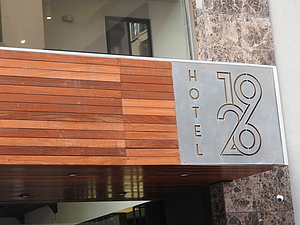
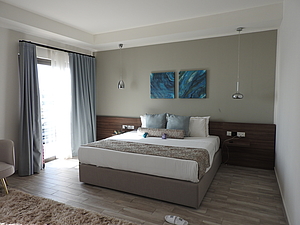
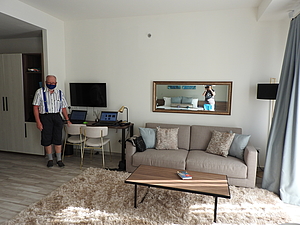
Anyway, we packed out in the original room. Fortunately, it turned out that nothing much was happening on the building site so far (we were most afraid of the noise), and we basically accepted the situation. However, a very nice marketing manager appeared and promised that she would arrange our relocation the next day (Lucie and Petra will remember how I won the fight for a room with a sea view on Korcula Island in Croatia, but in that case the sea view was paid in advance). To our surprise, she really did. The room on the top eleventh floor had a sea view on one side, a view at historic Valletta on the other one, a large terrace and was quite spacious.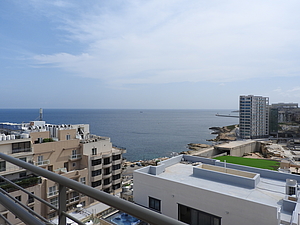
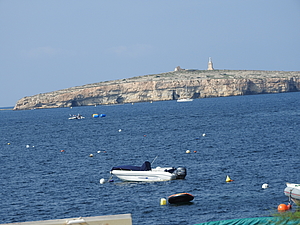
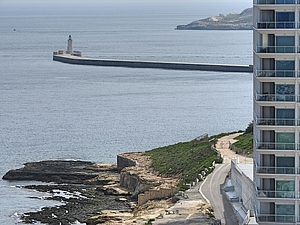
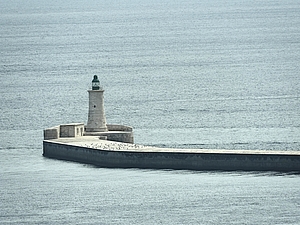
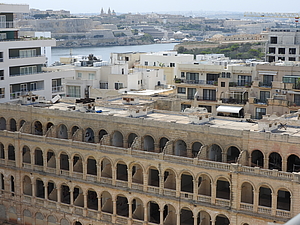
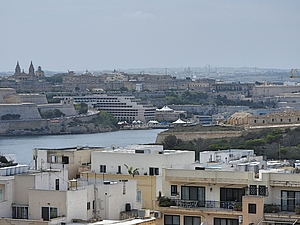
The hotel management did not request any surcharge, although the hotel was quite full with a very cosmopolitan society. People of all races (Asians, Africans, probably from the North Africa, Arabs, Europeans), of different religions (it is sometimes possible to recognize the religion according to clothing), speaking various languages (a lot of French and English, but we could hear also German, Arabic, Chinese, and of course Maltese), in all possible combinations - two girlfriends, two friends, couples. For some reason, mainly young people stayed in this hotel, I would say about eighty percent were around thirty and there were no families with children. We have not found the reason, because nowhere was written that the hotel would not accept children (there are some hotels that accommodate only children older than fourteen).
Breakfast was buffet style, but at Corona's time, guests were not allowed to touch anything, they showed the waiter what they wanted, and he put it on their plates. On arrival at the restaurant, everybody had to disinfect hands, and the waiter digitally measured everyone's temperature. The masks were obligatory everywhere in the hotel and could be taken off only at the table.
The spa in the hotel had a sauna and a small indoor pool, in my opinion best to be used like a large whirlpool, because it had a lot of massaging jets. You could also swim there, but already five guests were too much for a real swim (it was obligatory to make an appointment for both the swimming pools so that too many guests would not accumulate at the same time). However, the outdoor infinity zero edge swimming pool was big enough, blending visually with the sea and enabling also a beautiful view at the rocky shore.
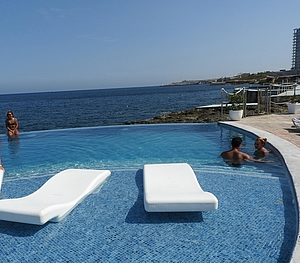
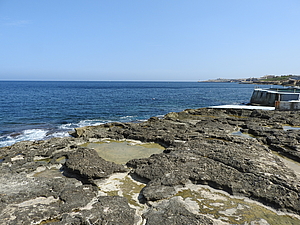
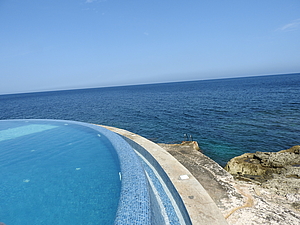
21st September
The first ride on a hop-on hop-off bus around so called northern circuit. It includes views of the Manoel Island, the port of Ta´Xbiex with beautiful villas of the local rich and their marina for yachts and the City Gate, entrance to the capital of Valletta. We passed several other towns, of which Mdina (Medina), originally a capital of Malta, is particularly important (we thoroughly explored it in the following days). In the close vicinity there is Rabat, a town that was a part of the Roman settlement (Domus Romana) where we got off and had our lunch. The bus stopped for impressive views also at the Golden Bay and the Bay of St. Paul. We acquired a good overview of the central and northern part of the island, however, sitting on the open upper deck of the bus in the temperature around thirty degrees was a tiring exercise. 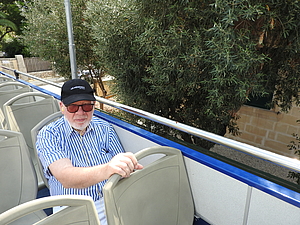
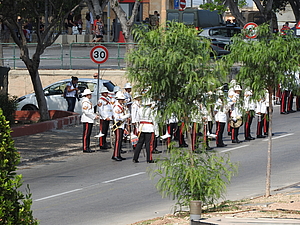
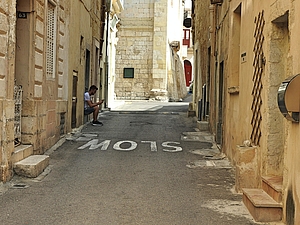
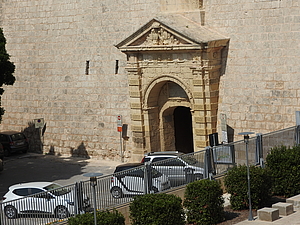
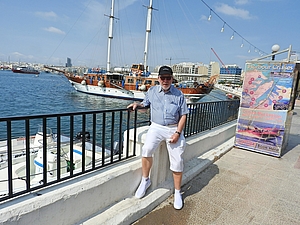
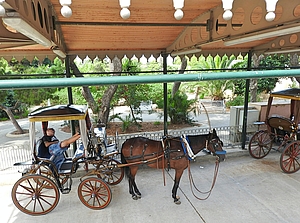
22nd September
The morning was basically wasted by business. George had to sit at the laptop to arrange for his electronic signature necessary for tax return in India. It took some time to get various codes, to record his voice on a video etc. In between I was enjoying our terrace view and reading.
We decided to spend the afternoon relaxing by the hotel's outdoor pool. The lunch was taken at the pool as well, for a dinner we discovered a very good restaurant Il Galeone on the promenade. I had ordered ravioli filled with rabbit meat, it was very tasteful and in the next days we visited this restaurant again.
23rd September
The second circuit on hop-on, hop-off bus - the so-called southern one. Because it was hot again, we planned to get off the bus at least three times. We wanted to see the Hypogeum, an underground Neolithic temple dating back to 2500 BC, protected by UNESCO; to have lunch in the picturesque fishing village of Marsaxlokk and end the day with a boat ride to the Blue Cave.
Nothing happened according to the plan. When we got off the bus at the place where we expected Hypogeum round the corner, we found out that it was about half an hour walk through hot streets, not speaking about the fact that one “helpful” native had sent us in a wrong direction. When we finally reached Hypogeum at around eleven, the lady at the till told us that they could not let us in until one o'clock, as it was necessary to make an appointment for this site by internet and numbers were strictly limited. So we gave up, walked half an hour back to the bus stop, waited for another half hour for the bus and completely exhausted abandoned the plan of a lunch in the fishing village – we wanted to take it at the Blue Cave instead.
As we ascended the imposing rocks that surround the Blue Cave, the staff explained that the water level in the cave was too low that day, so that boats to the Blue Cave could not operate. However, the surrounding rocky landscape was quite impressive. In my obsession with tasting Maltese dishes, I ordered a "Maltese salad" for lunch, which was awful, dry salad leaves with some different vegetables and small cucumbers without any dressing, topped with black beans bigilla spread, which I did not like either. Then we had to sit another two hours on hop-on, hop-off bus to get back to our hotel. It was not a very successful day, and we got a little bit sunburnt too. However, we made up for it in the evening with excellent seafood dinner and white wine.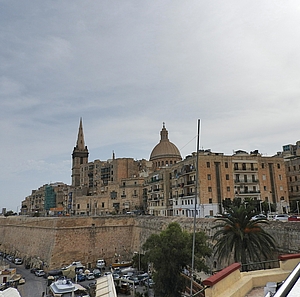
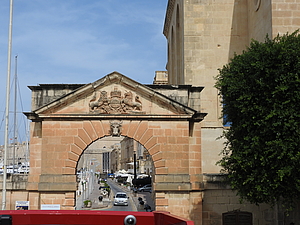
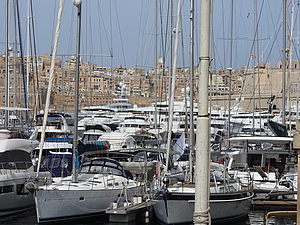
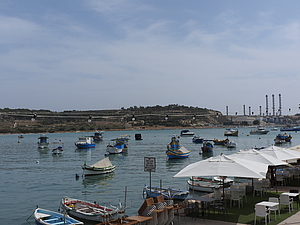
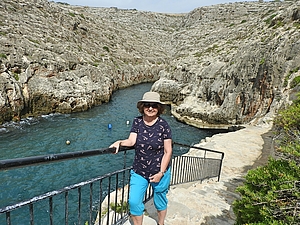
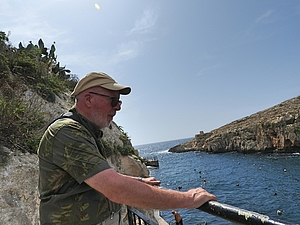
24th September
By ferry from Sliema to Valletta. Visit to the St. John's Co-Cathedral (the prefix co- means that it is shared by Maltese Order and Catholic bishop). Paintings by the Italian painter Mattio Preti, created in 5 years starting 1662, presenting 18 scenes from the life of St. John the Baptist. Preti received the title of a Maltese Knight for his work. However, the most famous painting in the oratorio at the transition from church to the museum comes from Caravaggio and depicts the moment just before beheading of St. John the Baptist on the order of Herod at the request of Salomé or, better said, of her mother (Beheading of St. John the Baptist). In this painting, Caravaggio used the dramatic illumination (tenebrism) with very pronounced chiaroscuro, violent contrasts of light and dark, with life-size figures inhabiting the huge space of the canvas. The effect is unbelievably impressive.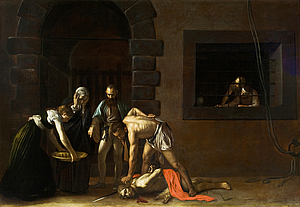
As a reward for this painting, Caravaggio was also admitted to the order of St. John, but he could enjoy it only for 6 months. After the Knights of Malta learnt that he was wanted in Rome for murder and after he attacked a respected member of the Order in Malta, he was expelled and put into prison. Fortunately, he managed to escape (Caravaggio painted two more paintings with the theme of St. John the Baptist, but in both of them the act of beheading is completed and Salomé already holds John the Baptist's head on a tray. One of these paintings is in Rome, the other in London.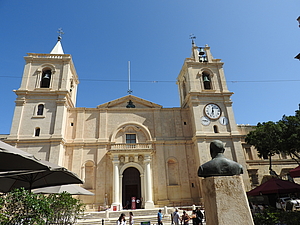
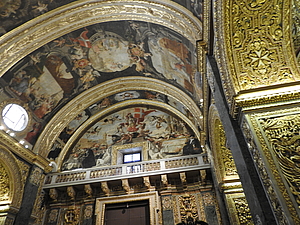
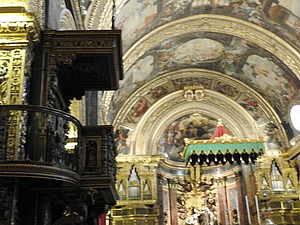
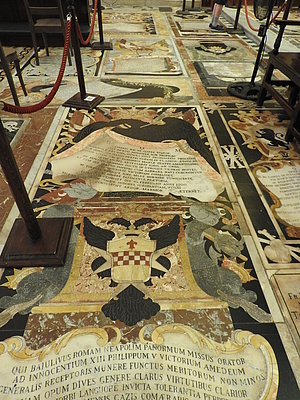
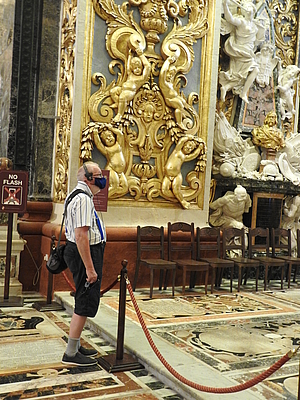
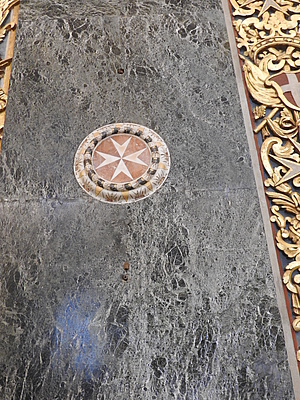
We walked through picturesque streets with many statues, including a statue of Jean de Vallette on Victory Street, Queen Victoria and others. We also passed the Ministry of Foreign and Europeans Affairs.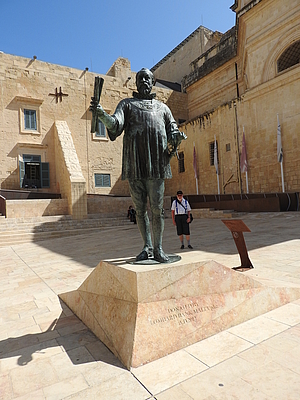
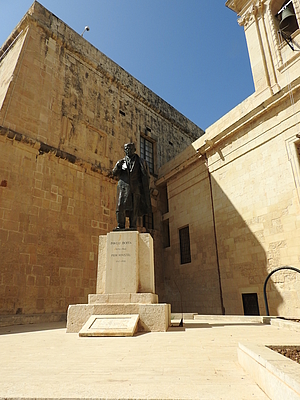
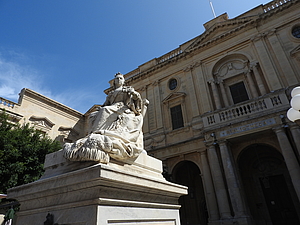
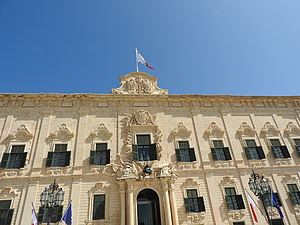
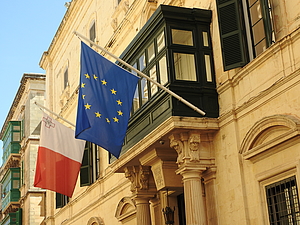
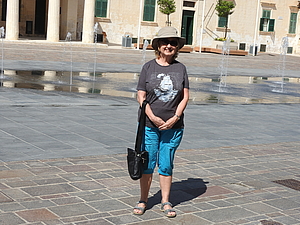
On the Republic Street the most impressive monument was built to the victims of the Great Siege by the Turks in 1565. The sculpture consists of three figures depicting Faith, Civilization, and Valor. Therefore it fits quite well that a photograph of Daphne Caruana Galizia with many flowers and has been placed in front of this monument. Caruana Galizia was an investigative journalist, focusing mainly on political corruption scandals, money laundering, and linking politics to organized crime. In October 2017, a bomb exploded in the car she was driving, and the uncomfortable person was removed forever. Recognition of the work of this fearless woman and solidarity with her family had been shown by people all over the world. The protest movement in Malta culminated in massive demonstrations from November 2019 till January 2020, which led to the resignation of the Prime Minister Muscat and other members of the government. There has also been a change in the presidency, with Marie-Louise Coleiro Preca being replaced by George William Vella, born in 1942. Carlo Bonini, an Italian mafia expert and author of a book on the investigations carried out by Caruana Galizia, described Malta as a "mafia-state”, revealing how also democracies can degenerate.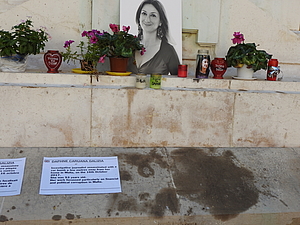
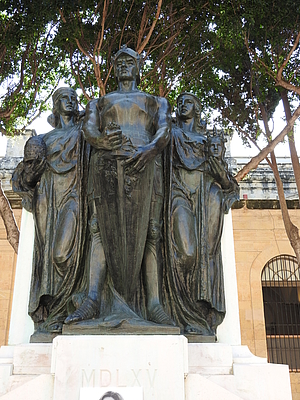
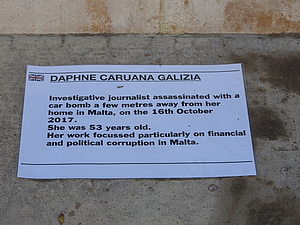
25th September
A day on a ship from Sliema to the islands Gozo and Comino. We had 3 stops on the island of Gozo. In the capital Victoria (named according to the Queen of England), we climbed the fortress of Cittadella, because, like Valletta and Mdina, Victoria is completely surrounded by massive fortifications. The Baroque cathedral inside the citadel dates from around 1700.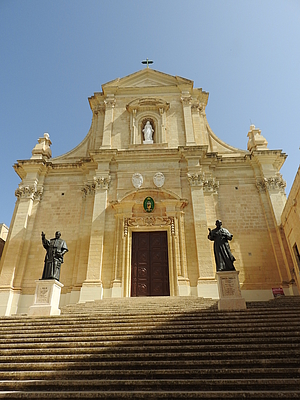
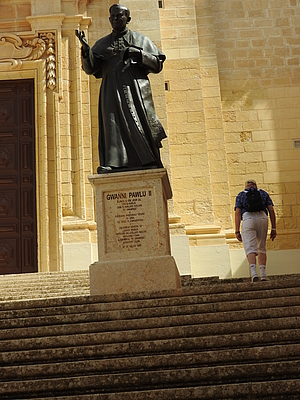
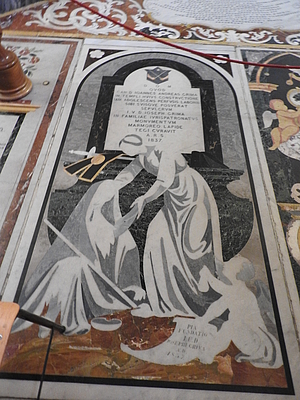
The second stop was at the natural rocky formations around Dwejra Bay, which we could observe from a boat. High cliffs separate the small lake from the open sea, but the water is permanently exchanging. However, the Azure Window, a famous 28 meters high limestone arch, fell into the sea during a storm in 2017. Azure Window in its intact form became famous through Hollywood films Clash of Titans (1981), The Count of Monte Cristo (2002) and the series The Game of Thrones.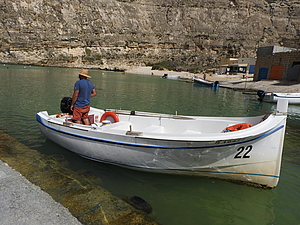
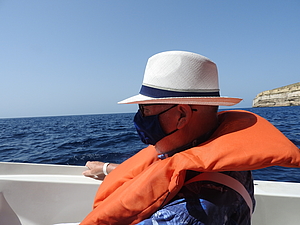
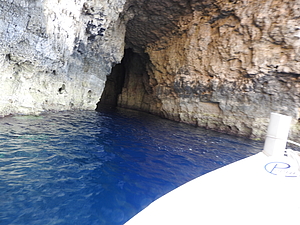

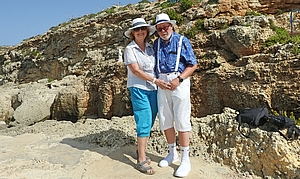
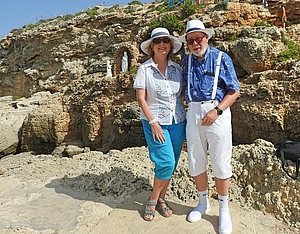
The entrance to the bay is guarded by a tower, with so called Fungus Rock situated opposite. Its vertical walls are towering above the surface to a height of 60 meters. It is home to the parasitic plant Cynomorium coccineum, heavily guarded in the times of Knights of Malta. They attributed to the fungus numerous healing effects and also used it to stimulate potency. Its theft was punishable by death.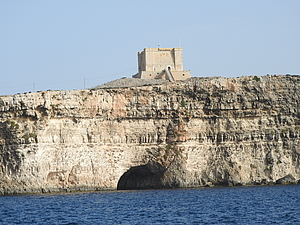
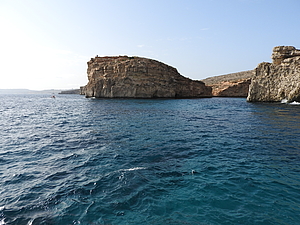
The cave of the nymph Calypso, which is unfortunately inaccessible to the public, is also located on the island. Here, according to the Greek mythology, Calypso held Ulysses for seven years and promised him immortality if he married her. She released him only on the direct order of the supreme god Zeus.
We could also have a quick look at the rotunda of Xewkija, dedicated to St. John the Baptist. It was built in the 20th century on the site of a former church and was designed by a well-known Maltese architect Joseph Damat. The inner diameter is 27 meters, height 75 meters, it is the third highest temple vault in the world without support, the dominant feature of the island. 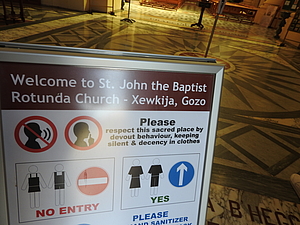
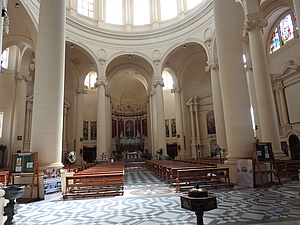
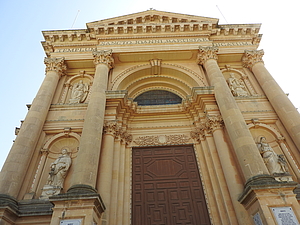
Then we continued our trip to the island of Comino, where the main attraction was to be the Blue Lagoon, all azure blue, as its name is suggesting. The sea was really blue, but otherwise it was a disappointment. In the small bay, a crowd of people gathered on the shore and in the water, with stalls selling burgers, hot dogs and similar assortment and of course a big selection of alcoholic beverages, especially cocktails. Having made a “reconnaissance of the terrain”, we returned to our ship and spent the remaining time till its departure there. The ship was well equipped, had also a toboggan directly into the sea, which was only used by a Muslim couple, a girl in a burqa swimsuit (burqini), him in a normal trunks, both swimming as fish and enjoying it. I did not dare to try J. The ship had glazed bottom which enabled an observation of the sea life.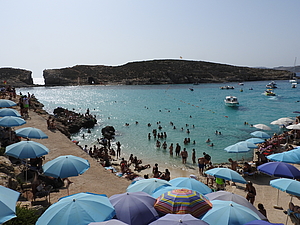
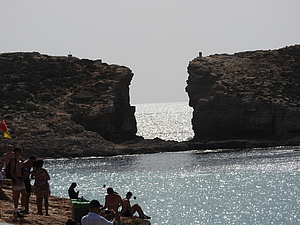
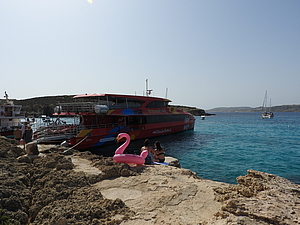
26th September
We sailed from Sliema to Valletta again, the shuttle takes about ten minutes and the cost of two senior return tickets was only 1.80 euros (in Malta, people over 60 count as seniors). We were walking past the fortifications to the longest main street of Valletta, Republic Street and to the Merchant Street, a charming road with shops, craft stands and outdoor restaurants. A statue of the abbati (altar boy) holds a collection box with inscription ‘Għinni nsir qassis’, meaning ‘Help me become a priest’. The statue is 60 years old.
We passed the building of the Royal Opera House, which was completely destroyed by one of the heavy air raids during the Second World War. It was restored after many ups and downs and rejected controversial proposals only in the form of an open-air theatre in 2013. Near the opera house there is a new parliament building, designed by the same architect as the opera, Renz Piano. The seat of the Parliament from its opening in 1921 was in the Grand Master´s Palace, it moved to a new building only in 2015. The construction of the Parliament was also accompanied by contradictions both due to its design and because of the increased building costs. The beautiful Triton Fountain stands out on the nearby spacious square.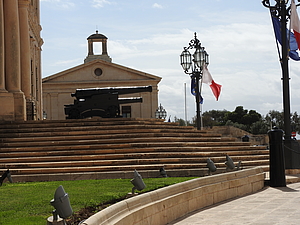

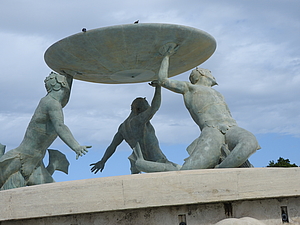
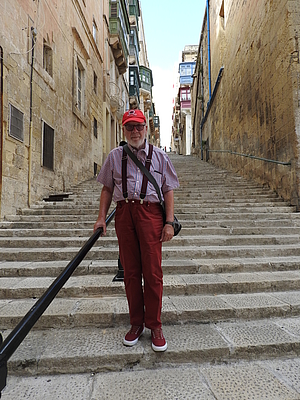
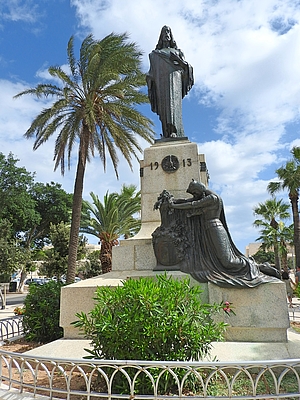
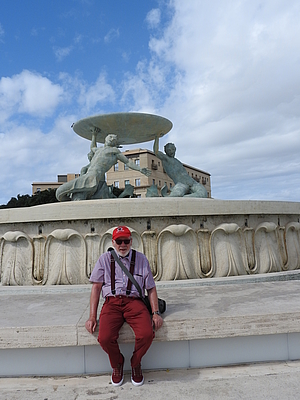
We passed the bastion of St. James and continued to the Upper Baracca Gardens with number of various statues and reliefs: Winston Churchill, Albert Einstein, Children of the Street (Les Gavroches), and more. On the ramparts with an amazing view at the Grand Habour we waited for a soldier in a British uniform who traditionally fires a cannon at noon (Saluting Battery), which is a big tourist attraction in Valletta. However, I expected him to fire all ten cannons to make it really a big bang and the only shot with a little bit of smoke was not very impressive. 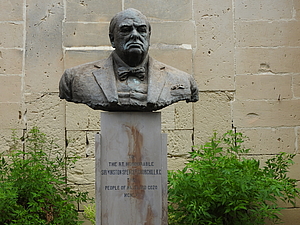
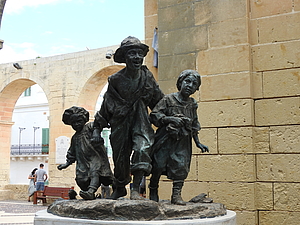
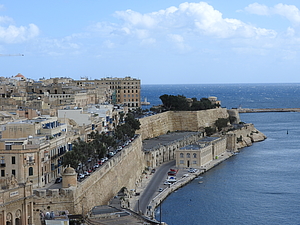
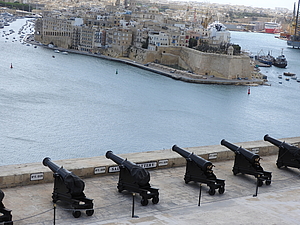
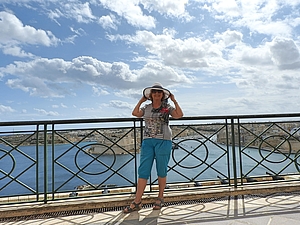
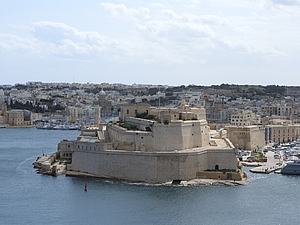
The garden´s terraced arches were originally roofed, but the ceiling was removed following the Rising of the Priests in 1775. This was an uprising led by clergy against the Order of Saint John who had sovereignty over Malta. The newly elected Grand Master Francisco Ximenes de Texada became unpopular for austerity measures, for increasing the price of corn and especially for banning the hunt of hares by the common people. However, on the day of uprising only 18 of 28 clergymen and some laymen appeared. The rebellion was suppressed by the Order within a few hours. The rebels were then captured and some were executed, exiled or imprisoned.
The walk was very pleasant because it cooled down to 25 degrees. In Sliema it was forbidden to swim in the sea. A thunder storm at night raised high waves which were flooding the rocks at the coast. Also our "beach club" - the outdoor pool with a restaurant - were closed. The hotel left for the guests a small bottle of champagne in the room as a compensation.
27th September
We spent the morning at the beach club, in the afternoon we ordered a taxi to take us to Paola.
The first interesting site in Paola is the Catholic Basilica of Christ the King. It was awarded the title of basilica by a Vatican decree in April 2020.
It is also home to Malta's only mosque, Mariam Al-Battool. The foundation stone for its construction was laid by Libyan President Muammar Gaddafi in 1978, and it was officially opened in 1984, when Malta and Libya signed a treaty of friendship and cooperation. The complex includes a school, an Islamic cultural center promoting Sunni Islam, a courtyard, an imam's house, a cemetery and a Mediterranean garden (first Muammar Gaddafi's garden, later the Libyan, now the Mediterranean Garden). Of the estimated 3,000 Muslims in Malta, approximately 2,250 are foreigners, approximately 600 are naturalized citizens, and approximately 150 are native-born Maltese.
The most unique monument in Paola is the megalithic monument Hypogeum (Greek hypo "under" and gaia "earth" = lying under the ground), which was discovered by accident in 1902. This is an underground ceremonial space (temple), which we had tried to visit unsuccessfully at the beginning of our stay.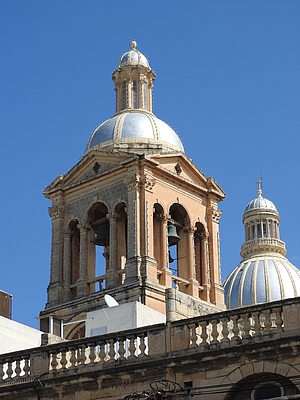
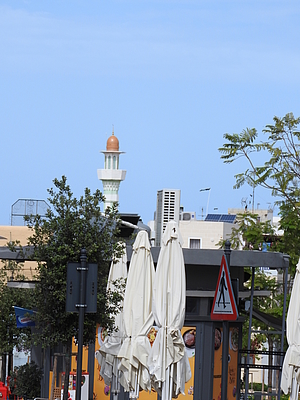
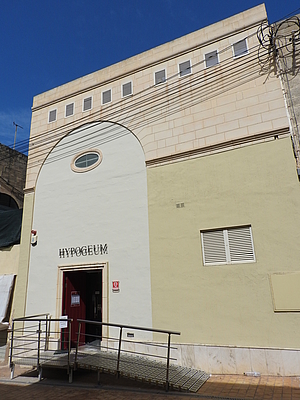
There is a total of seven preserved temples from the megalithic period in Malta, known as one of the oldest temples in history, some dating from before the Egyptian pyramids and before the stone structures of Stonehenge. The Egyptian pyramids at Giza have long been thought to be the largest and oldest preserved architectural monuments in the world. However, scientists have proven that the Ggantija complex, built on the Maltese island of Gozo from massive stone blocks, was formed 3600 years BC, a thousand years before the pyramids.
However, the Hypogeum is the only labyrinth of underground passages and chambers carved into the rock. It gradually expanded over a period of 1300 years, beginning in 3800 BC. The whole complex is huge - it has three floors, it is about 11 meters deep. In total, it covers an area of about 500 square meters, its walls are partially decorated with ocher paintings which are the only kept prehistoric murals ever. 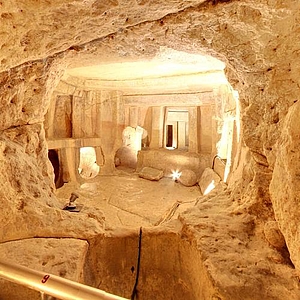
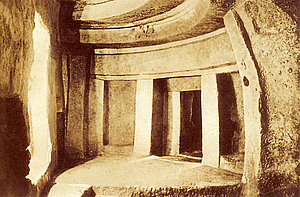
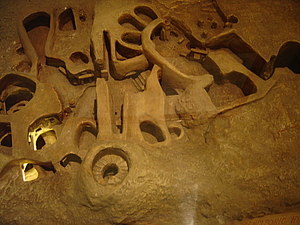
In countless smaller niches, the remains of the bones of around 7000 people, all females, were found, leading some researchers to conclude that the Hypogeum was built by a matriarchal society and that it was a burial place for priestesses. The only statuette of a sleeping woman found in the cave was called by archeologists a Sleeping Priestess.
The Hypogeum has been closed for a long time in recent years to prevent the complete destruction. It was reopened in 2017 and presently is accessible under very strict conditions. Only fifty visitors are admitted daily, with a maximum of ten people in a group, a visit had to be booked via internet. All luggage, handbags, cameras, headgear, etc. had to be left in lockers at the till. Due to the Corona pandemic, everybody was obliged to disinfect hands and have his/her temperature digitally measured, the face masks, of course, were mandatory. The underground was slippery, with a feeble lighting, and it was wise to hold on the railings and watch the head. Definitely not suitable for people suffering from claustrophobia. However, during the tour, I was awed by the uniqueness of the place built by a completely unknown civilization almost six thousand years ago.
28th September
We set off again by ferry to Valletta. First we found a large dome that dominates Valletta from the sea, the catholic Church of Our Lady of Mount Carmel where we attended part of the mass in Maltese.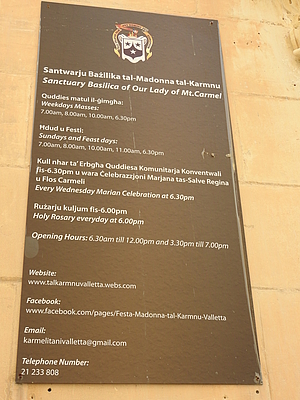
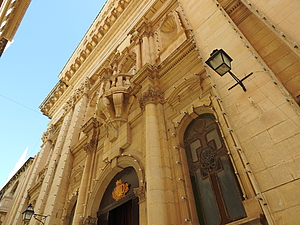
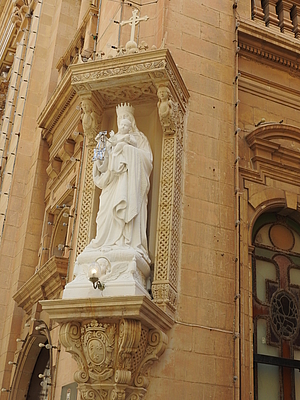
The next door is the Anglican pro-cathedral of St. Paul, the foundation stone of which was laid by queen Adelaide in 1839. 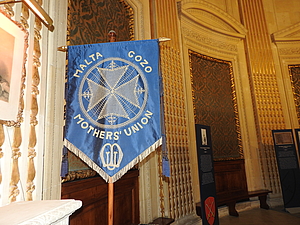
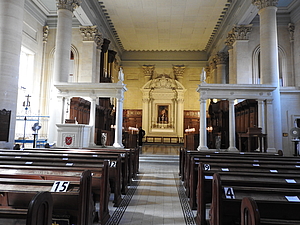
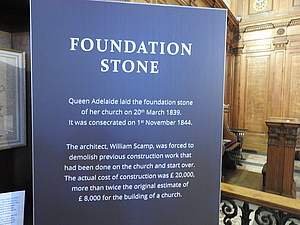
The third oldest European theater, Manoel, is under reconstruction, but they let us in, so we could see not only the auditorium, but also how the workers transported material on stage by a wheel barrow. But we didn't hear the famous ghost, the mistress of the theatre builder Grandmaster Vilhena, who is said to sing lullabies during theatrical rehearsals.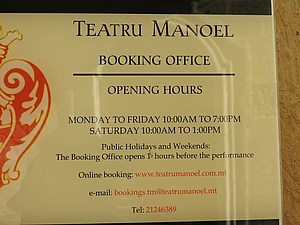
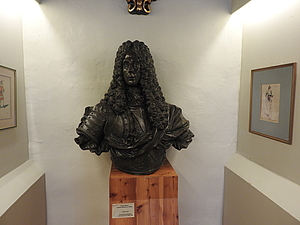
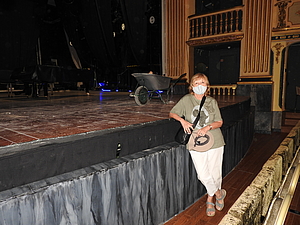
Our next stop, Casa Rocca Piccola is a palace built at the end of the 16th century, where the aristocratic de Piro family still lives on the upper floor, but it has opened the lower floors to the public since 2019. The house also includes a bunker, which served as a cover during the bombing of Valletta during World War II. At that time, the owners made it accessible to the neighbors and other residents of the district. The most charming is a surrounding small garden with orange trees, Macaw parrot and two turtles in the pool under a baroque statue.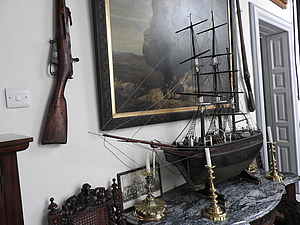
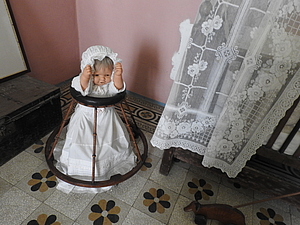
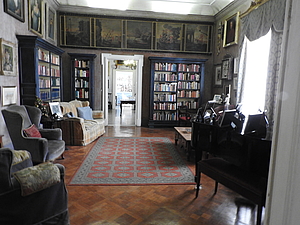
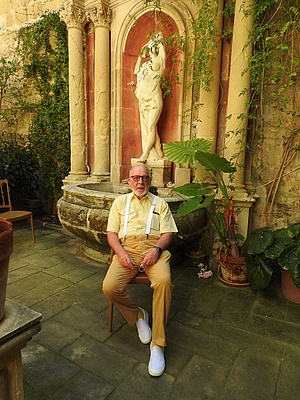
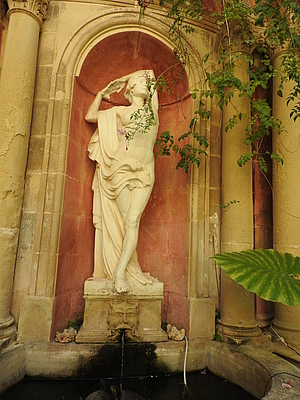
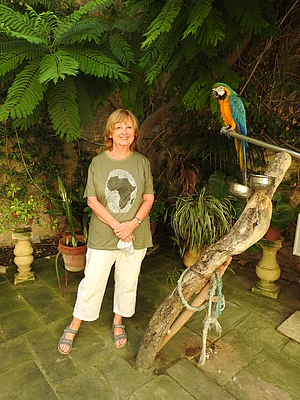
29th September
We ordered a taxi and took a ride to the medieval town of Mdina, the former capital of the island, which is connected by the Howard Gardens to the town of Rabat. Mdina rises above the island of Malta on a hill almost 200 meters high, its massive walls built in today's size in the 9th century by Arab tribes. The fortification of Mdina withstood an attack by the Turks in 1422. When Malta was handed over to the Knights of Malta, the importance of the town diminished as the Knights chose Valletta as their capital. Although an important university remained, the town's population continued to decline.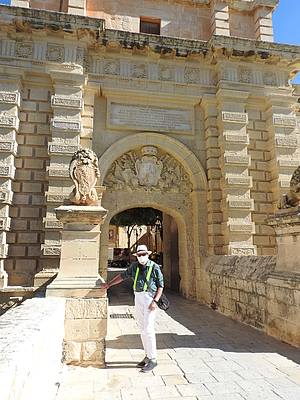
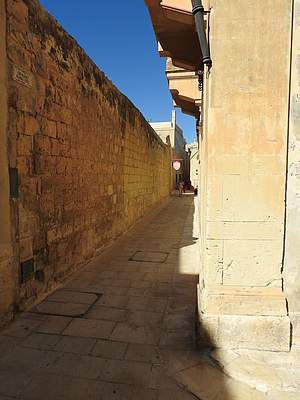
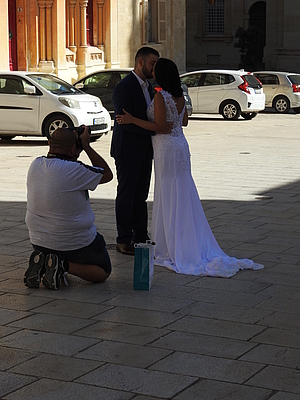
Today, Mdina is accessible only for pedestrians and for horse-drawn carriages, called karozzins. Our coachman was skillfully driving us through narrow romantic lanes. The town was almost deserted, sometimes only the clatter of our horse's hooves could be heard.
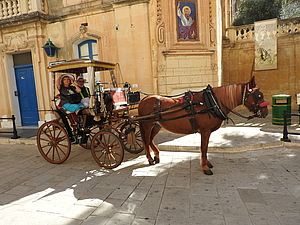
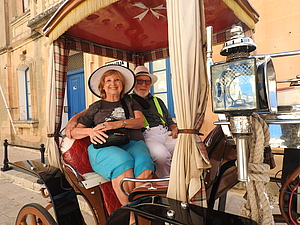
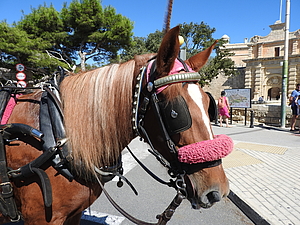
240 inhabitants live in the Mdina palaces, all of them belonging to the most affluent strata of society. Presently only 10 nuns remain living in the Benedictine monastery (when a woman enters this monastery, she is never allowed to leave it). The famous Inguanez Palace (Casa Inguanez) is standing opposite the Benedictine chapel. The Inguanez family is the oldest surviving aristocratic family in Malta - the original palace was built as early as 1370, but has been rebuilt several times. Many members of European royal families have spent the night there. It is said to have eighty rooms, as our coachman informed us. The main Roman Catholic cathedral is dedicated to St. Paul the Apostle. The cathedral was founded in the 12th century, and according to tradition it stands on the site of where Roman governor Publius met St. Paul following his shipwreck on Malta. It had long belonged to the Bishop of Malta and was rebuilt after the earthquake in 1693. It continues to compete with the Co-Cathedral of St. John in Valletta, belonging to the Knights of Malta.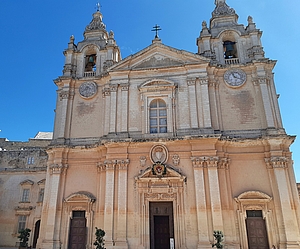
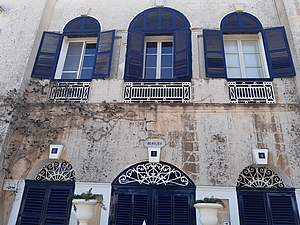
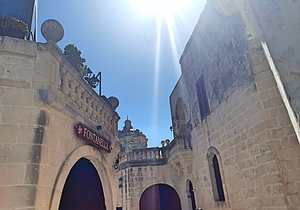
Mdina has many haunting ghost stories. One of them is about a woman walking in the dark streets, dressed in a traditional black ghonnella, who invites the night pedestrians to follow her, and then walks through the wall before their eyes. Ghonnella or faldetta is a hooded cloak made from either silk or cotton, reinforced at the top with either cardboard, cane or whalebone. Part of the ghonnella rises above the woman's head like a blanket, she holds its lower parts clasped in her right hand. Today, however, hot pants are more visible in Malta than ghonnella.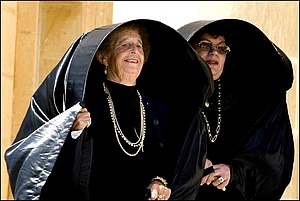
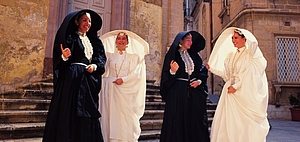
As we stepped out of the fiacre, we walked through the narrow streets on our own and found the gifts we were looking for in several small shops. Malta produces colorful glass, which can compete with Murano glass for its splendor, and it is a popular souvenir, but we have no longer any space for such items, no matter how much we would like them.
In the evening we took our last walk along the waterfront promenade and said goodbye to familiar places.
30th September
Departure from Malta to Frankfurt. The trip went without problems, we only had to solve some small issues which is always the case when travelling. The actual flight went smoothly (of course, it is necessary to have a mask on the plane at all times, food is not served). At the Frankfurt Airport, we needed to get a trolley (they are not free at the most German airports, you have to pay one Euro for them), but the slot machine did not take coins because of Corona and refused to accept credit cards either. Together with other desperate passengers with a lot of luggage, we tried several times on several devices, no success. Once we already started to worry that the machine had swallowed our card, but after a while and pressing all the buttons, it was fortunately spat out again.
This meant that we had to drag our two big and one small suitcases without trolley to the railway station. When we got there, we found out that the train was half an hour late, and when it finally arrived, the order of the wagons was changed, so that we had to board quickly the wagon which stopped next to us but was not ours. Pulling our suitcases three or four wagons further on the train going at nearly three hundred kilometers per hour swinging from side to side would not have been fun. Fortunately, a conductor appeared, and after George complained about Deutsche Bahn's services, he told us that we could stay seated where we boarded, and leave our suitcases behind other seats, because the train was nearly empty and so it would stay. He also offered cappuccino as a compensation for all the trouble. In two and half hours we reached Dortmund. The journey from the hotel in Malta to Villa Tremonia took totally ten hours.
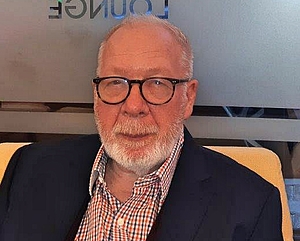
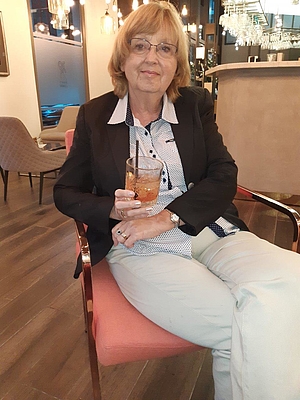
Conclusion: Before the start of our journey, we were hesitant whether to go or not due to the global pandemic situation. But we were happy that we decided to go and that we got acquainted with Malta, a new country for both of us. Besides the historical monuments and natural beauties, the country has also a helpful easy going English speaking population (children start learning English from the age of 5), which all together made our stay pleasant and memorable. We also got a little bit of suntan before returning to the cold Central European autumn weather.